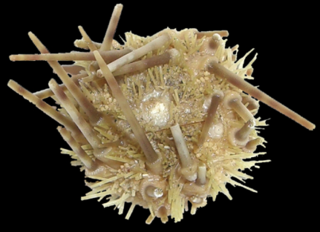
Araeosoma thetidis is a species of sea urchin of the family Echinothuriidae. This species can be found in deep sea off Australia and New Zealand. A. thetidis was first scientifically described in 1909 by Hubert Lyman Clark.
Brisaster antarcticus is a species of sea urchins of the Family Schizasteridae. Their armour is covered with spines. Brisaster antarcticus was first scientifically described in 1906 by Döderlein.
Brisaster capensis is a species of sea urchins of the Family Schizasteridae. Their armour is covered with spines. Brisaster capensis was first scientifically described in 1880 by Studer. It is endemic to South Africa.
Brisaster fragilis is a species of sea urchins of the Family Schizasteridae. Their armour is covered with spines. Brisaster fragilis was first scientifically described in 1844 by Düben & Koren.
Brisaster kerguelenensis is a species of sea urchins of the Family Schizasteridae. Their armour is covered with spines. Brisaster kerguelenensis was first scientifically described in 1917 by Hubert Lyman Clark.
Caenopedina alanbakeri is a species of sea urchins of the Family Pedinidae. Their armour is covered with spines. Caenopedina alanbakeri was first scientifically described in 1989 by Rowe.
Caenopedina annulata is a species of sea urchins of the Family Pedinidae. Their armour is covered with spines. Caenopedina annulata was first scientifically described in 1940 by Ole Theodor Jensen Mortensen.
Caenopedina cubensis is a species of sea urchins of the Family Pedinidae. Their armor is covered with spines. Caenopedina cubensis was first scientifically described in 1869 by Alexander Emanuel Agassiz.
Caenopedina depressa is a species of sea urchins of the Family Pedinidae. Their armour is covered with spines. Caenopedina depressa was first scientifically described in 1927 by Koehler.
Caenopedina diomedeae is a species of sea urchins of the Family Pedinidae. Their armour is covered with spines. Caenopedina diomedeae was first scientifically described in 1939 by Ole Theodor Jensen Mortensen.

Caenopedina hawaiiensis is a species of sea urchins of the Family Pedinidae. Their armor is covered with spines. Caenopedina hawaiiensis was first scientifically described in 1912 by Hubert Lyman Clark.
Caenopedina indica is a species of sea urchins of the Family Pedinidae. Their armour is covered with spines. Caenopedina indica was first scientifically described in 1903 by de Meijere.

Caenopedina mirabilis is a species of sea urchins of the Family Pedinidae. Their armour is covered with spines. Caenopedina mirabilis was first scientifically described in 1885 by Döderlein.
Caenopedina novaezealandiae is a species of sea urchins of the Family Pedinidae. Their armour is covered with spines. Caenopedina novaezealandiae was first scientifically described in 1964 by Pawson.
Caenopedina otagoensis is a species of sea urchins of the Family Pedinidae. Their armour is covered with spines. Caenopedina otagoensis was first scientifically described in 1968 by McKnight.
Caenopedina porphyrogigas is a species of sea urchins of the Family Pedinidae. Their armour is covered with spines. Caenopedina porphyrogigas was first scientifically described in 2009 by Anderson.
Caenopedina pulchella is a species of sea urchins of the family Pedinidae. Their armour is covered with spines. Caenopedina pulchella was first scientifically described in 1907 by Alexander Emanuel Agassiz and Hubert Lyman Clark.
Caenopedina superba is a species of sea urchins of the family Pedinidae. Their armour is covered with spines. Caenopedina superba was first scientifically described in 1925 by Hubert Lyman Clark.
Calocidaris micans is a species of sea urchins of the Family Cidaridae. Their armour is covered with spines. Calocidaris micans was first scientifically described in 1903 by Ole Mortensen.
Clypeaster euclastus is a species of sea urchins of the Family Clypeasteridae. Their armour is covered with spines. Clypeaster euclastus was first scientifically described in 1941 by Hubert Lyman Clark.




